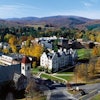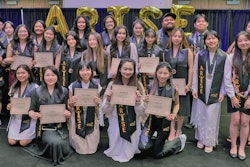A Faltering Picture of Diversity
Minority journalists don’t have to consult industry surveys to know that their representation in the newsroom falls far below parity
By Ben Hammer
Catalina Camia remembers how stunned she was when at a banquet for an Asian American community group in the late 1980s, a lawyer she had been speaking with for 15 minutes complimented her on her English and asked how long she had been in the country. After all, she was well known in city government circles as a Dallas Morning News beat reporter whose stories often landed on the front page.
Whether they began working in journalism three years or three decades ago, most minority newspaper editors and reporters can offer firsthand testimony about an atmosphere that was unwelcoming when they entered the profession.
“You’re constantly battling for a sense of who you are and what you can do,” says Camia, now a regional editor who oversees congressional and national security coverage at Gannett News Service. “You’re constantly battling against people who have preconceptions of who you are and perhaps even stereotypes and that’s hard to do.”
Minority journalists don’t have to consult industry surveys to know that their representation in the newsroom falls far below parity, and many say this won’t change until newspapers focus as much on retaining and promoting minority hires as they do on simply bringing them in the front door.
In April, the American Society of Newspaper Editors (ASNE) released its annual survey of minority journalists, showing little positive change over the previous year. U.S. newspapers saw an increase of just 40 Black journalists nationwide, or just 0.04 percent, after two years of decline. Minorities held just 12.5 percent of all newspaper jobs, the survey found.
The percentage of minorities in management positions fell from 20 percent to 19 percent, according to the survey. The report also showed that the percentage of minority interns fell in 2003 to 30.6 percent of all interns, down from 31.1 percent last year. Almost 40 percent of responding newspapers said that they had no journalists of color working for them, representing mostly small and midsize papers.
Industry Efforts to Increase Ranks
“Despite the numbers, there is lots and lots of evidence that the industry is trying to accomplish this thing called diversity with honorable speed and urgency,” says Keith Woods, resident expert on diversity issues and coverage of race at the Poynter Institute in St. Petersburg, Fla. “But we still wind up with an industry that doesn’t know how to handle it when it gets it, so we’re losing people because of that.”
Woods is the group leader for reporting, writing and editing at Poynter, which offers training and resources to journalists. Its staff also consults with industry groups.
The Freedom Forum, an international foundation committed to free speech and free press, sponsors several programs whose goal is to increase diversity at American newspapers. Last year it launched its Diversity Institute at Vanderbilt University, offering 17 mid-career professionals three months of training in journalism before placing them in positions at their local sponsoring newspaper (see Black Issues, Aug. 16, 2001).
The Freedom Forum also administers the ASNE/Associated Press Managing Editors Diversity Fellows program, begun in fall 2000. The organization committed $1 million to fund up to 50 minority journalists who agree to work at newspapers with a circulation of 75,000 or less for up to two years in return for a $5,000 stipend every six months. The program’s goal is to enable smaller newspapers to compete for minority journalists despite the low salaries they offer.
“Editors are very, very receptive to programs that the Freedom Forum has because it doesn’t cost them a lot, but when it comes to training programs and spending money on (diversity efforts)… I don’t see newspapers spending a lot,” says Wanda Lloyd, executive director of the Freedom Forum’s Diversity Institute.
But the Freedom Forum’s largest diversity program to date has been the Chips Quinn Scholars program, which since 1991 has given more than 800 minority college students a week of training in journalism, placement at news internships and a $1,000 scholarship. In 2003, 27 scholars participated in the spring and 74 scholars participated in the summer.
The Dow Jones Newspaper Fund (DJNF) is another major facilitator of internships for minorities. Each summer, the fund gives 30 minority college students two weeks of intensive training and then places them at copy editing internships.
The fund also runs a business reporting program for minority college students. Since 1995, about 10 students per year have attended a training seminar at New York University’s department of journalism before starting a business reporting internship at a daily newspaper or financial newswire.
The DJNF also offers grants for programs that encourage minority high school students who are considering careers in journalism, and to high school newspapers with a concentration of students of color.
The National Association of Black Journalists (NABJ) and the Associated Press Sports Editors (APSE) run a Sports Journalism Institute that offers 10 minority college students a week of training and placement at a paid summer internship at a daily newspaper.
In addition, NABJ will bring 55 college students to its upcoming conference in August for a weeklong student development program where they will put together a newspaper, television and radio broadcasts and an online homepage for the convention.
Some major newspaper companies have their own recruitment and training programs to increase their minority ranks. The Knight Ridder Scholars program offers four-year scholarships and a guaranteed summer newspaper internship to as many as a dozen minority high school students each year.
The company also offers minority college graduates a two-year program that includes a year at a small paper and a second year at a larger publication. The company’s goal is to hire them full-time upon completion, says Bryan Monroe, assistant vice president for news at Knight Ridder, and NABJ vice president for print.
The Tribune Company runs a Minority Editorial Training Program (METPRO) with the specific goal of training and hiring minorities that it can place at one of its 11 newspapers. Each year, the company trains 10 prospective copy editors at Newsday and 10 prospective reporters at the Los Angeles Times before placing them at one of its newspapers for a second year of work. About 240 minority journalists have graduated from the program.
Retention: Still a Major Concern
The newspaper industry has been losing jobs for many years, leaving fewer openings for everyone. Many professionals say the dot-com phenomenon led many journalists to look outside the industry for higher paying jobs. Also, news organizations have cut costs in all areas during the current economic downturn, including diversity programs.
Some African American editors say advocacy groups that called for increased diversity have fallen silent since much progress was made in the 1980s. Since then, cutbacks have left the remaining staff with more work than ever before, and less time to focus on improving diversity and coverage of race relations.
“There just seems to not be the same kind of push or need for diversity as there was in certain times,” says Lonnie Isabel, Newsday‘s assistant managing editor for foreign and national affairs. “None of this happens unless there is agitation.”
Isabel says that today’s affirmative action candidate has to be a “sure thing,” and that editors aren’t as willing as they used to be to rollup their sleeves and train new journalists.
Newspapers need to do more than just hire minorities to accurately reflect what goes on in the communities they cover, minority editors point out.
“You have to be the whole package and be sincere about it,” says Walter Middlebrook, associate editor for recruitment at Newsday, which has one of the country’s most diverse staffs, according to this year’s ASNE survey. “Reporters and editors know that we have to have people of color in our newspaper. It’s just our way of doing business.”
Many experts point to journalism schools as another reason for the faltering diversity picture. Fewer men have been enrolling in journalism programs because of a perception that the industry is low-paying, say journalism school faculty and industry experts. Also, many editors say universities don’t stress the importance of internships early enough.
Journalism programs at HBCUs are often underfunded and as a result, offer poor technical training and don’t have enough staff to advise a daily student newspaper.
Another major complaint is that universities don’t have enough faculty with real-world journalism experience. Editors suggest that schools partner with local media to improve journalism departments and to reach out to minority students within and outside the department interested in pursing the field.
“Usually, people get frustrated and turned off to the business because of the experiences they had in college,” says Gregory Lee, NABJ secretary and deputy high school sports editor at the Washington Post. “In order to ease them in and keep those numbers high I think you really have to go into the schools and upgrade those programs.” Lee focuses his work at the NABJ on young journalists.
A few journalism programs are following the kind of model that diversity proponents support. Wayne State University partnered with local area media executives to fund its Journalism Institute for Minorities, a program that offers $1,000 a semester to as many as 40 students of color. The program’s director acts as a mentor and adviser to the institute’s enrollees, and each summer they attend a retreat focusing on minorities in the media. Also, importantly, all members of the school’s journalism staff are actively involved in journalism.
“In my position here, I could not be on a tenure track position because I do not have a Ph.D.,” says the institute’s director Sandra Combs Birdiett. “But I believe my students are better served because of my 21 years of professional experience and 8 years as a freelancer.”
Florida A&M University is midway through construction of a $20 million building for its school of journalism, media and graphic arts, set to be completed in June 2004. The centerpiece of the new school will be a multi-media newsroom featuring the convergence of print, online, radio and television facilities.
The only problem is that the school is $2.5 million short on funds for the broadcast equipment in the building and was denied $1.5 million in matching funds by the state for other furniture and equipment.
Despite updating its facilities to match the modern day realities of the industry, FAMU will continue to focus on providing a basic journalism education rather than offering a more specialized curriculum, says Dean Robert Ruggles.
While editors say journalism schools need to be reformed, many experts agree that the industry needs to go outside the established pipeline to find minority journalists.
“There are a lot of talented people who have the writing skills and the critical thinking skills and who have the curiosity about the world who aren’t necessarily at journalism schools or big schools,” says Camia, a former Freedom Forum Traveling Diversity Fellow and the 1999-2000 president of the Asian American Journalists Association.
In 2000-2001, the Freedom Forum sent four Traveling Diversity Fellows to visit 210 college campuses with large populations of students of color with the goal of increasing the number of minority journalists entering the profession. The fellows compiled a directory of minority students interested in the profession for the industry to use in its recruiting efforts.
But whether the problem begins or ends at journalism schools or in the newsroom, Black professionals agree that the solution begins with recognizing issues of race and addressing them openly.
“You recognize the dynamic and you acknowledge it and say it out loud to the people you work with,” says the Poynter Institute’s Woods. “Just like the newsroom, the classroom has to become a place where this discussion takes place out in the open rather than after week 13 and before ethics.”
© Copyright 2005 by DiverseEducation.com


















